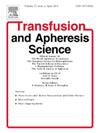A predictive score model based on complete blood count for a single-unit red blood cell transfusion
IF 1.2
4区 医学
Q4 HEMATOLOGY
引用次数: 0
Abstract
Background
Red blood cell (RBC) transfusions are life-saving options for those who are unable to carry oxygen. Although administering a single RBC unit usually elicits a sufficient response, identifying the optimal transfusion trigger can be challenging because this variable remains unknown.
Objectives
This study aimed to develop a one-unit RBC Transfusion Requirement Scoring Model (1RTRSM), a predictive scoring system through studying the value of each CBC parameter and basic demographics of the patients. Methods: A five-year, retrospective study of patients requesting a single unit of RBC transfusion was carried out to determine the variables influencing transfusion, develop a scoring tool, and pilot test it one year prospectively. Age, sex, ABO grouping and Rh(D) typing department and CBC parameters were included. Based on transfusion status, the results were divided in cases and controls. The score was determined, and the cut-off was assigned using the receiver operating characteristic curve.
Results
Totally, 10,995 individuals - 4635 controls and 6320 cases - were included. They were selected to construct the score considering they possessed positively predicted one-unit RBC transfusion: male, age ≥ 43 years, Hb < 8.9, g/dL, RDW ≥ 15.0 %, PLT < 229.9 × 10 ³ /μL, and MPV < 9.9 fL. The total score value of 5 was chosen as the cut-off with strengths of 87 % accuracy, 89 % sensitivity and 85 % specificity. Within a pilot study, the score's accuracy over all departments was 85 %.
Conclusions
We established a novel 1RTRSM model that predicts patients' transfusion needs across a variety of departments using a simple, valid and reliable tool demonstrating high accuracy.
基于全血细胞计数的单单位红细胞输血预测评分模型
背景:对于那些无法携带氧气的人来说,输血是挽救生命的选择。虽然给予单个RBC单位通常会引起足够的反应,但确定最佳的输血触发因素可能具有挑战性,因为这个变量仍然未知。目的通过研究患者的CBC各参数值和基本人口统计学特征,建立单单位红细胞输血需求评分模型(1RTRSM)。方法:对需要单单位红细胞输血的患者进行为期5年的回顾性研究,以确定影响输血的变量,开发评分工具,并进行前瞻性1年的试点测试。包括年龄、性别、ABO分型、Rh(D)分型科室及CBC参数。根据输血情况,结果分为病例和对照组。确定评分,并使用受试者工作特征曲线分配截止值。结果共纳入10995人,其中对照组4635人,病例6320人。他们选择构建评分考虑拥有积极预测单位红细胞输血:男性,年龄≥ 43年,Hb & lt; 8.9 g / dL, RDW≥15.0 %,PLT & lt; 229.9 × 10 ³ /μL和MPV & lt; 9.9 fL。选择总分5作为分界点,准确度为87 %,灵敏度为89 %,特异性为85 %。在一项初步研究中,该分数在所有部门的准确率为85% %。我们建立了一种新的1RTRSM模型,该模型使用一种简单、有效、可靠的工具来预测不同科室患者的输血需求,并且具有很高的准确性。
本文章由计算机程序翻译,如有差异,请以英文原文为准。
求助全文
约1分钟内获得全文
求助全文
来源期刊
CiteScore
3.60
自引率
5.30%
发文量
181
审稿时长
42 days
期刊介绍:
Transfusion and Apheresis Science brings comprehensive and up-to-date information to physicians and health care professionals involved in the rapidly changing fields of transfusion medicine, hemostasis and apheresis. The journal presents original articles relating to scientific and clinical studies in the areas of immunohematology, transfusion practice, bleeding and thrombotic disorders and both therapeutic and donor apheresis including hematopoietic stem cells. Topics covered include the collection and processing of blood, compatibility testing and guidelines for the use of blood products, as well as screening for and transmission of blood-borne diseases. All areas of apheresis - therapeutic and collection - are also addressed. We would like to specifically encourage allied health professionals in this area to submit manuscripts that relate to improved patient and donor care, technical aspects and educational issues.
Transfusion and Apheresis Science features a "Theme" section which includes, in each issue, a group of papers designed to review a specific topic of current importance in transfusion and hemostasis for the discussion of topical issues specific to apheresis and focuses on the operators'' viewpoint. Another section is "What''s Happening" which provides informal reporting of activities in the field. In addition, brief case reports and Letters to the Editor, as well as reviews of meetings and events of general interest, and a listing of recent patents make the journal a complete source of information for practitioners of transfusion, hemostasis and apheresis science. Immediate dissemination of important information is ensured by the commitment of Transfusion and Apheresis Science to rapid publication of both symposia and submitted papers.

 求助内容:
求助内容: 应助结果提醒方式:
应助结果提醒方式:


